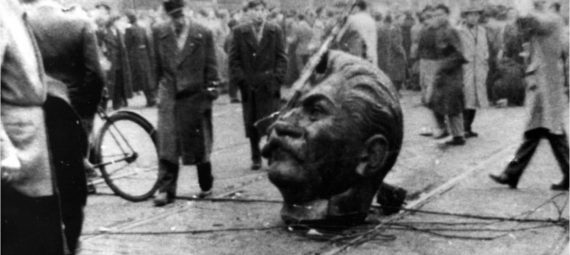On October 22, 1956, Hungarians took to Parliament Square in Budapest to protest the Pro-Stalinist regime in Hungary. The movement, led mainly by students and workers, advocated for economic and social reforms and the removal of Stalinist leaders like Mátyás Rákosi. The Hungarian Revolt came shortly after Khrushchev, Premier of the Soviet Union, denounced Joseph Stalin’s cult of personality and dictatorial rule. Hungarians took the words of Khruschev seriously and sought to overthrow the government and reject soviet control and repression. In response, the Soviet Government instituted Imre Nagy as the premier, with the hope that it would quell the protests. Nagy then tried to institute a multi-party system and withdraw Hungary from the Warsaw Pact, a military alliance of soviet controlled states.
The Kremlin took these actions as a threat to their control in Hungary and sent in military forces to Budapest. Unarmed civilians were gunned down on October 25, which resulted in an all-out war between Hungarian Peasants and the Soviet army. Hungarians fought for their lives, using Molotov cocktails and rifles stolen from the military. Because of broadcasts by Radio Free Europe, many continued to fight because they thought the United States would intervene. Although a ceasefire was reached on October 28th, the worst was yet to come. On November 4th, Khrushchev and his allies decided that the loss of a satellite state would not be accepted at any cost and instituted a brutal counter-attack that resulted in a Soviet victory. By the end of the conflict, thousands of Hungarians had died, many more fled the country, and Nagy was executed.
The events that occurred in Budapest in 1956 were demonstrative of the lengths that the Kremlin was willing to go in order to keep their control over their satellite states. The brutal repression of the Hungarian Uprising demonstrated to the other satellite states that there were a series of rules that they had to follow while operating in the Soviet Bloc. The first of these was that no state was allowed to leave the Warsaw Pact. As exemplified by Hungary, Nagy’s desire to leave the Warsaw Pact was met with swift, armed punishment. Second, no state was to reform or abolish the communist monopoly. Nagy’s institution of a multi-party rule was taken as an affront to Soviet control and was another reason for the armed resistance.
The events in Hungary were also indicative of underlying unrest in Soviet Bloc states at economic stagnation and repression. As a result, leaders in these states had to reform while abiding by the Kremlin’s rules. They had to adjust without being accused of becoming market-oriented. In Poland, Władysław Gomułka, newly instituted in 1956, sought to increase the relationship between church and state while also re-commercializing agriculture. Frightened by the events in Budapest, he denied any further reforms, opting instead for economic stagnation. In East Germany, Walter Ulbricht also sought economic reforms, eliminating quantitative targets for efficiency in favor of profit-centered ones. He also increased wages and leisure time, instituting a 5 day work week. The new Hungarian leader, János Kádár, extended the rights of trade unions and increasing trade deals with the West for technology. In short, with the haunting example of the Hungarian revolt in mind, leaders had to reconcile reforms with Soviet control.
In the United States, the Hungarian revolution was hailed as an inspiring grassroots embrace of liberalism. On December 23rd, 1956, The New York Times released an article titled “Youth vs. Communism: A Hungarian’s Story”. In this article, a Hungarian student and revolutionary, protected by the pseudonym “Janos Hollo”, tells the story of how students organized and fought bravely against the Soviet army. Hollo writes about how students, the ones mainly indoctrinated into Communist ideology, were the ones at the helm of the revolt. The article takes an overtly pro-west stance, with Hollo writing that he was “not a hero, because the individual heroes died and remained nameless”. The writer takes an obviously critical tone of communism, saying that the students rose up because of a “dictatorship which robs people of their identity”, adding that the regime perpetrated “horrors reminiscent of the darkest middle ages. It did not succeed in hiding its lies, its cruelties, its catastrophic economic difficulties behind its loud propaganda machinery”. Although the article does not comment on US involvement in the matter, the publishing of this article shows that the New York Times was willing to give an audience to voices of revolution.
Bibliography
Craig, Campbell, and Fredrik Logevall. America’s Cold War: The Politics of Insecurity. Cambridge, Massachusetts; London, England: Harvard University Press, 2009. Accessed February 14, 2021. doi:10.2307/j.ctvjnrs49.
Encyclopedia Britannica. “Hungary – The Kádár Regime.” Accessed February 14, 2021. https://www.britannica.com/place/Hungary.
JANOS HOLLO. 1956. “Youth Vs. Communism: A Hungarian’s Story: For Ten Years Hungary’s Young People were Indoctrinated in Communism. Yet, when Revolt Flared, they were in the Vanguard. here as Refugee Freedom Fighter Tells Why. Youth Vs. Communism–A Hungarian’s Story.” New York Times (1923-Current File), Dec 23, 102. http://newman.richmond.edu:2048/login?url=https://www.proquest.com/historical-newspapers/youth-vs-communism-hungarians-story/docview/113668839/se-2?accountid=14731.
Kemp-Welch, Anthony. “Eastern Europe: Stalinism to Solidarity.” Chapter. In The Cambridge History of the Cold War, edited by Melvyn P. Leffler and Odd Arne Westad, 2:219–37. The Cambridge History of the Cold War. Cambridge: Cambridge University Press, 2010. doi:10.1017/CHOL9780521837200.012
“Remembering ’56: The Hungarian Revolution | Origins: Current Events in Historical Perspective.” Accessed February 14, 2021. https://origins.osu.edu/milestones/october-2016-remembering-56-hungarian-revolution-sixty.

